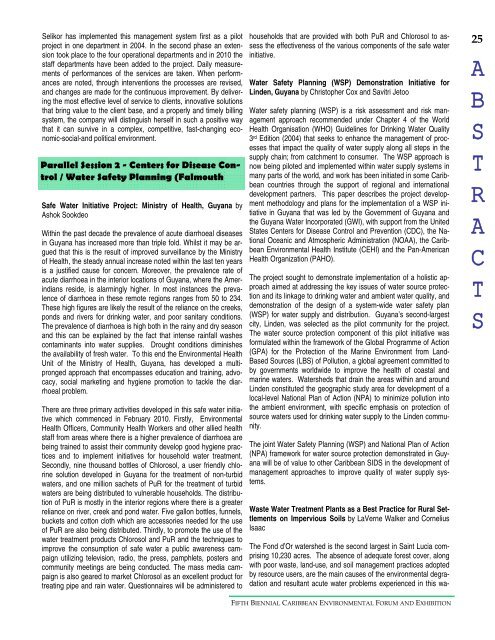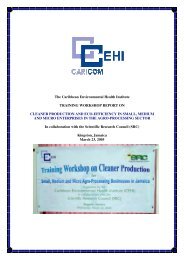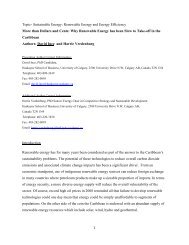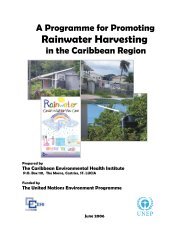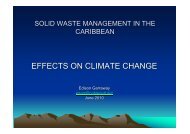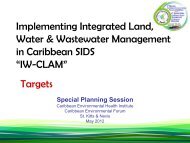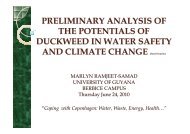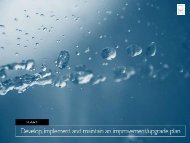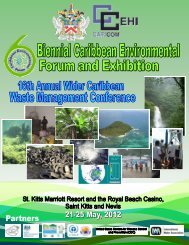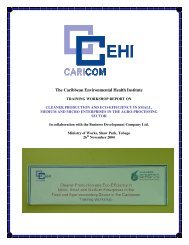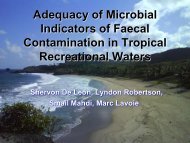conference magazine - Caribbean Environmental Health Institute
conference magazine - Caribbean Environmental Health Institute
conference magazine - Caribbean Environmental Health Institute
You also want an ePaper? Increase the reach of your titles
YUMPU automatically turns print PDFs into web optimized ePapers that Google loves.
Selikor has implemented this management system first as a pilot<br />
project in one department in 2004. In the second phase an extension<br />
took place to the four operational departments and in 2010 the<br />
staff departments have been added to the project. Daily measurements<br />
of performances of the services are taken. When performances<br />
are noted, through interventions the processes are revised,<br />
and changes are made for the continuous improvement. By delivering<br />
the most effective level of service to clients, innovative solutions<br />
that bring value to the client base, and a properly and timely billing<br />
system, the company will distinguish herself in such a positive way<br />
that it can survive in a complex, competitive, fast-changing economic-social-and<br />
political environment.<br />
Parallel Session 2 - Centers for Disease Control<br />
/ Water Safety Planning (Falmouth<br />
Safe Water Initiative Project: Ministry of <strong>Health</strong>, Guyana by<br />
Ashok Sookdeo<br />
Within the past decade the prevalence of acute diarrhoeal diseases<br />
in Guyana has increased more than triple fold. Whilst it may be argued<br />
that this is the result of improved surveillance by the Ministry<br />
of <strong>Health</strong>, the steady annual increase noted within the last ten years<br />
is a justified cause for concern. Moreover, the prevalence rate of<br />
acute diarrhoea in the interior locations of Guyana, where the Amerindians<br />
reside, is alarmingly higher. In most instances the prevalence<br />
of diarrhoea in these remote regions ranges from 50 to 234.<br />
These high figures are likely the result of the reliance on the creeks,<br />
ponds and rivers for drinking water, and poor sanitary conditions.<br />
The prevalence of diarrhoea is high both in the rainy and dry season<br />
and this can be explained by the fact that intense rainfall washes<br />
contaminants into water supplies. Drought conditions diminishes<br />
the availability of fresh water. To this end the <strong>Environmental</strong> <strong>Health</strong><br />
Unit of the Ministry of <strong>Health</strong>, Guyana, has developed a multipronged<br />
approach that encompasses education and training, advocacy,<br />
social marketing and hygiene promotion to tackle the diarrhoeal<br />
problem.<br />
There are three primary activities developed in this safe water initiative<br />
which commenced in February 2010. Firstly, <strong>Environmental</strong><br />
<strong>Health</strong> Officers, Community <strong>Health</strong> Workers and other allied health<br />
staff from areas where there is a higher prevalence of diarrhoea are<br />
being trained to assist their community develop good hygiene practices<br />
and to implement initiatives for household water treatment.<br />
Secondly, nine thousand bottles of Chlorosol, a user friendly chlorine<br />
solution developed in Guyana for the treatment of non-turbid<br />
waters, and one million sachets of PuR for the treatment of turbid<br />
waters are being distributed to vulnerable households. The distribution<br />
of PuR is mostly in the interior regions where there is a greater<br />
reliance on river, creek and pond water. Five gallon bottles, funnels,<br />
buckets and cotton cloth which are accessories needed for the use<br />
of PuR are also being distributed. Thirdly, to promote the use of the<br />
water treatment products Chlorosol and PuR and the techniques to<br />
improve the consumption of safe water a public awareness campaign<br />
utilizing television, radio, the press, pamphlets, posters and<br />
community meetings are being conducted. The mass media campaign<br />
is also geared to market Chlorosol as an excellent product for<br />
treating pipe and rain water. Questionnaires will be administered to<br />
households that are provided with both PuR and Chlorosol to assess<br />
the effectiveness of the various components of the safe water<br />
initiative.<br />
Water Safety Planning (WSP) Demonstration Initiative for<br />
Linden, Guyana by Christopher Cox and Savitri Jetoo<br />
Water safety planning (WSP) is a risk assessment and risk management<br />
approach recommended under Chapter 4 of the World<br />
<strong>Health</strong> Organisation (WHO) Guidelines for Drinking Water Quality<br />
3 rd Edition (2004) that seeks to enhance the management of processes<br />
that impact the quality of water supply along all steps in the<br />
supply chain; from catchment to consumer. The WSP approach is<br />
now being piloted and implemented within water supply systems in<br />
many parts of the world, and work has been initiated in some <strong>Caribbean</strong><br />
countries through the support of regional and international<br />
development partners. This paper describes the project development<br />
methodology and plans for the implementation of a WSP initiative<br />
in Guyana that was led by the Government of Guyana and<br />
the Guyana Water Incorporated (GWI), with support from the United<br />
States Centers for Disease Control and Prevention (CDC), the National<br />
Oceanic and Atmospheric Administration (NOAA), the <strong>Caribbean</strong><br />
<strong>Environmental</strong> <strong>Health</strong> <strong>Institute</strong> (CEHI) and the Pan-American<br />
<strong>Health</strong> Organization (PAHO).<br />
The project sought to demonstrate implementation of a holistic approach<br />
aimed at addressing the key issues of water source protection<br />
and its linkage to drinking water and ambient water quality, and<br />
demonstration of the design of a system-wide water safety plan<br />
(WSP) for water supply and distribution. Guyana’s second-largest<br />
city, Linden, was selected as the pilot community for the project.<br />
The water source protection component of this pilot initiative was<br />
formulated within the framework of the Global Programme of Action<br />
(GPA) for the Protection of the Marine Environment from Land-<br />
Based Sources (LBS) of Pollution, a global agreement committed to<br />
by governments worldwide to improve the health of coastal and<br />
marine waters. Watersheds that drain the areas within and around<br />
Linden constituted the geographic study area for development of a<br />
local-level National Plan of Action (NPA) to minimize pollution into<br />
the ambient environment, with specific emphasis on protection of<br />
source waters used for drinking water supply to the Linden community.<br />
The joint Water Safety Planning (WSP) and National Plan of Action<br />
(NPA) framework for water source protection demonstrated in Guyana<br />
will be of value to other <strong>Caribbean</strong> SIDS in the development of<br />
management approaches to improve quality of water supply systems.<br />
Waste Water Treatment Plants as a Best Practice for Rural Settlements<br />
on Impervious Soils by LaVerne Walker and Cornelius<br />
Isaac<br />
The Fond d’Or watershed is the second largest in Saint Lucia comprising<br />
10,230 acres. The absence of adequate forest cover, along<br />
with poor waste, land-use, and soil management practices adopted<br />
by resource users, are the main causes of the environmental degradation<br />
and resultant acute water problems experienced in this wa-<br />
25<br />
A<br />
B<br />
S<br />
T<br />
R<br />
A<br />
C<br />
T<br />
S<br />
FIFTH BIENNIAL CARIBBEAN ENVIRONMENTAL FORUM AND EXHIBITION


